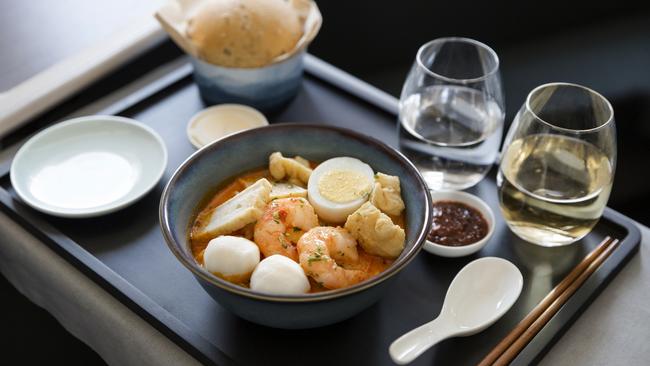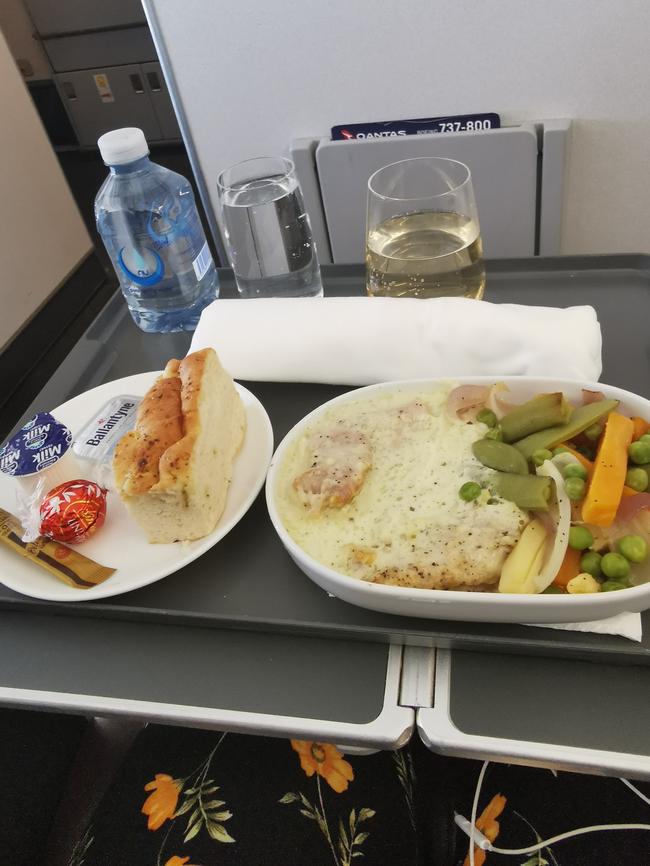From paddock to plane – the complex process of producing 100 airline meals a minute
Love it or hate it, airline food is big business and a massive exercise in logistics to get from paddock to plane. Dnata Catering reveals how it’s done.
Business
Don't miss out on the headlines from Business. Followed categories will be added to My News.
Love it or hate it, airline food is a big part of the travel experience and the process of getting from paddock to plane is an extraordinarily complex operation.
Australia’s biggest airline catering company, the Emirates-owned dnata, dishes up 65 million meals a year across more than 250,00 flights from 15 facilities across the country.
The figures equate to over 100 meals a minute — ranging from a simple pre-packaged snack or ready-made frozen meal from dnata’s Snapfresh factory, to a first class three-course dinner.
At one of the largest centres in Brisbane, dnata churns out meals for 16 airlines, all with their own menus, crockery and presentation styles across various cabin classes.
Hygiene is all important, and fruit and vegetables go through a sanitisation process before use and workers wear hair nets, coats and gloves.
Knives are kept in individual lockers for security reasons, with the facility directly accessible from the Brisbane Airport tarmac. Inside the kitchens separated into Halal and non-Halal, a cook-chill-plate process is adhered to with all meals for international flights prepared within 48-hours of departure.
Even premium cabin meals are cooked no less than 8-hours before takeoff, due to the required 4-hour chilling process.
For domestic flights the window reduces to a minimum of two-hours, with most meals sourced from Snapfresh.

Dnata catering Australia CEO Hiranjan Aloysius will not say what it costs to produce each meal with the company working within each airline’s budget.
But he says what airlines are prepared to spend, dictates whether travellers might enjoy a side salad and dessert with their main course with some carriers “more generous” than others.
“Different airlines have different perceptions of what they should offer,” says Mr Aloysius.
“A lot of the Middle East carriers we find are very generous, certainly Qantas is very generous with their meals. For the Asian carriers, it’s a bit of a mix, particularly the ones that are still struggling will have very strong budget constraints and we do have some European carriers who operate on a smaller budget so it does vary quite a bit.”
If catering budgets become too restrictive, dnata “politely exits because it’s our reputation and people will blame the caterer”.
He hints there are some “difficult discussions” going on at the moment due to the cost of food and the fares being charged by airlines.
“Food inflation is by default in most parts of the world a lot higher than the inflation that is published and for us to be able to recover that cost is very very difficult because of the way our pricing is set,” Mr Aloysius says.
“It’s quite a difficult environment for us to operate in when fares are at record levels but airline caterers still have to work at trying to make sure the price is right. It’s a challenge we’re working with our airline partners on to make sure there’s a fair sharing of the cost burden.”

Another increasing challenge for airline caterers, is the growing demand for “special meals” such as vegetarian, vegan, dairy-free, gluten-free and so on.
In total, dnata catering offers a choice of 21 special meals which cannot be the same across all airlines.
Passenger boards in the dnata catering kitchen, show for one Singapore Airlines’ flight of about 300 people, close to 60 special meals had been ordered.
Mr Aloysius says numbers continue to rise but not because more people are becoming gluten or lactose intolerant.
“People are no longer ordering special meals because they have an actual allergen or particular religious belief. They’re actually ordering it because it’s a healthier option, it’s better for the environment or it’s responsibly sourced,” he says.
“We’ve helped to mitigate the challenge by producing (special meals) centrally through Snapfresh, otherwise the sheer volume of what’s happening would not be possible.”
Whereas in the past airlines provided menus for caterers to replicate, Mr Aloysius says it’s now much more collaborative with dnata catering advising on seasonal produce and local preferences.
He says Australians make up the majority of passengers carried in and out of the country by their airline customers and the meals generally reflect that.
“We know the market, and we know the tastes of that area,” says Mr Aloysius.
“Collaboration also allows us to do what’s in season which helps from a cost perspective. For instance if an airline wants strawberries and they’re not in season, they pay more for that.”
Once meals are loaded into carts, a fleet of 110 trucks takes them to aircraft for loading – carrying enough for up to four planes at a time.
Checklists taped to each cart aim to ensure all items are present, with no room for error.
“There’s no store in the sky if we forget something,” he smiles.
Originally published as From paddock to plane – the complex process of producing 100 airline meals a minute



